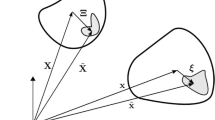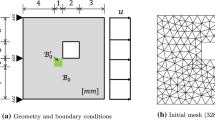Abstract
A computationally efficient numerical strategy called as variational differential quadrature-finite element method (VDQFEM) is developed herein for the nonlinear analysis of hyperelastic micromorphic continua. To this end, a novel formulation including microstructure effects is proposed in which high-order tensors are written in equivalent matrix or vector forms, and is then discretized in an efficient way. This feature is utilized in the coding process of numerical method. For the solution purpose, the domain is first transformed into a number of finite elements. Thereafter, a variational discretization technique called as VDQ is applied within each element. In order to employ the VDQ method, the irregular domain of the element is transformed into the regular one using the mapping technique. Finally, the assemblage procedure is performed. This approach can be used for the analysis of bodies with arbitrary geometries. By considering several numerical examples, it is revealed that the presented size-dependent formulation and numerical solution approach have a good performance to study the large deformations of hyperelastic micromorphic bodies with complex geometries.

















Similar content being viewed by others
References
Aifantis, E.C.: On the microstructural origin of certain inelastic models. J. Eng. Mater. Technol. 106, 326–330 (1984)
Fleck, N.A., Muller, G.M., Ashby, M.F., Hutchinson, J.W.: Strain gradient plasticity: theory and experiment. Acta Metall. Mater. 42, 475–487 (1994)
Ma, Q., Clarke, D.R.: Size dependent hardness of silver single crystals. J. Mater. Res. 10, 853–863 (1995)
McElhancy, K.W., Valsssak, J.J., Nix, W.D.: Determination of indenter tip geometry and indentation contact area for depth sensing indentation experiments. J. Mater. Res. 13, 1300–1306 (1998)
Stolken, J.S., Evans, A.G.: A microbend test method for measuring the plasticity length scale. Acta Metall. Mater. 46, 5109–5115 (1998)
Bazant, Z.P.: Size effect. Int. J. Solid Struct. 37, 69–80 (2000)
Abu Al-Rub, R.K., Voyiadjis, G.Z.: Analytical and experimental determination of the material intrinsic length scale of strain gradient plasticity theory from micro- and nano-indentation experiments. Int. J. Plast. 20, 1139–1182 (2004)
Nemat-Nasser, A., Hori, M.: Micromechanics: Overall Properties of Heterogeneous Materials, 2 revised edn. Elsevier, North-Holland (1999)
Barchiesi, E., Spagnuolo, M., Placidi, L.: Mechanical metamaterials: a state of the art. Math. Mech. Solids 24, 212–234 (2019)
Reiher, J.C., Giorgio, I., Bertram, A.: Finite-element analysis of polyhedra under point and line forces in second-strain gradient elasticity. J. Eng. Mech. 143, 04016112-1–13 (2017)
Andreaus, U., dell’Isola, F., Giorgio, I., Placidi, L., Lekszycki, T., Rizzi, N.L.: Numerical simulations of classical problems in two-dimensional (non) linear second gradient elasticity. Int. J. Eng. Sci. 108, 34–50 (2016)
Laudato, M., Di Cosmo, F.: Euromech 579 Arpino 3–8 April 2017: generalized and microstructured continua: new ideas in modeling and/or applications to structures with (nearly) inextensible fibers–a review of presentations and discussions. Contin. Mech. Thermodyn. 30(5), 1011–1025 (2018)
Cosserat, E., Cosserat, F.: Théorie des corps déformables., Paris (1909)
Eringen, A.C., Suhubi, E.: Nonlinear theory of simple micro-elastic solids—I. Int. J. Eng. Sci. 2, 189–203 (1964)
Suhubi, E., Eringen, A.C.: Nonlinear theory of micro-elastic solids—II. Int. J. Eng. Sci. 2, 389–404 (1964)
Eringen, A.C.: Simple microfluids. Int. J. Eng. Sci. 2, 205–217 (1964)
Eringen, A.C.: Theory of micropolar plates. Zeitschrift für angewandte Mathematik und Physik ZAMP 18, 12–30 (1967)
Ieşan, D.: On the linear theory of micropolar elasticity. Int. J. Eng. Sci. 7, 1213–1220 (1969)
Nowacki, W.: Theory of Micropolar Elasticity. Springer, Berlin (1970)
Capriz, G.: Continua with Microstructure. Springer, Berlin (1989)
Eringen, A.C.: Microcontinuum Field Theories I: Foundations and Solids. Springer, New York (1999)
Dyszlewicz, J.: Micropolar Theory of Elasticity. Springer, Berlin (2004)
Trovalusci, P., Masiani, R.: Non-linear micropolar and classical continua for anisotropic discontinuous materials. Int. J. Solids Struct. 40, 1281–1297 (2003)
Chen, Y., Lee, J.D.: Determining material constants in micromorphic theory through phonon dispersion relations. Int. J. Eng. Sci. 41, 871–886 (2003)
Chen, Y., Lee, J.D.: Connecting molecular dynamics to micromorphic theory. (I). Instantaneous and averaged mechanical variables. Physica A: Stat. Mech. Appl. 322, 359–376 (2003)
Chen, Y., Lee, J.D.: Connecting molecular dynamics to micromorphic theory. (II). Balance laws. Physica A: Stat. Mech. Appl. 322, 377–392 (2003)
Randow, C., Gray, G., Costanzo, F.: A directed continuum model of micro-and nano-scale thin films. Int. J. Solids Struct. 43, 1253–1275 (2006)
Sansour, C., Skatulla, S., Zbib, H.: A formulation for the micromorphic continuum at finite inelastic strains. Int. J. Solids Struct. 47, 1546–1554 (2010)
Wang, X., Lee, J.D.: Micromorphic theory: a gateway to nano world. Int. J. Smart Nano Mater. 1, 115–135 (2010)
Isbuga, V., Regueiro, R.A.: Three-dimensional finite element analysis of finite deformation micromorphic linear isotropic elasticity. Int. J. Eng. Sci. 49, 1326–1336 (2011)
Altenbach, H., Eremeyev, V.A.: Strain rate tensors and constitutive equations of inelastic micropolar materials. Int. J. Plast. 63, 3–17 (2014)
He, J.H.: A family of variational principles for linear micromorphic elasticity. Comput. Struct. 81, 2079–2085 (2003)
Lee, J.D., Wang, X.: Generalized micromorphic solids and fluids. Int. J. Eng. Sci. 49, 1378–1387 (2011)
Romano, G., Barretta, R., Diaco, M.: Micromorphic continua: non-redundant formulations. Contin. Mech. Thermodyn. 28, 1659–1670 (2016)
Forest, S., Sab, K.: Finite-deformation second-order micromorphic theory and its relations to strain and stress gradient models. Math. Mech. Solids. (2017). https://doi.org/10.1177/1081286517720844
Neff, P., Madeo, A., Barbagallo, G., Valerio d’Agostino, M., Abreu, R., Ghiba, I.D.: Real wave propagation in the isotropic-relaxed micromorphic model. Proc. R. Soc. A Math. Phys. Eng. Sci. (2017). https://doi.org/10.1098/rspa.2016.0790
Eremeyev, V.A., Lebedev, L.P., Cloud, M.J.: Acceleration waves in the nonlinear micromorphic continuum. Mech. Res. Commun. (2017). https://doi.org/10.1016/j.mechrescom.2017.07.004
Kuhl, E., Askes, H., Steinmann, P.: An ALE formulation based on spatial and material settings of continuum mechanics. Part 1: generic hyperelastic formulation. Comput. Methods Appl. Mech. Eng. 193, 4207–4222 (2004)
Kirchner, N., Steinmann, P.: On the material setting of gradient hyperelasticity. Math. Mech. Solids 12, 559–580 (2007)
Hirschberger, C.B.: A Treatise on Micromorphic Continua. Theory, Homogenization, Computation. Doctoral Thesis (2008)
Hirschberger, C.B., Kuhl, E., Steinmann, P.: On deformational and configurational mechanics of micromorphic hyperelasticity—theory and computation. Comput. Methods Appl. Mech. Eng. 196, 4027–4044 (2007)
Leismann, T., Mahnken, R.: Transition from hyperelastic micromorphic to micropolar and microstrain continua. PAMM Proc. Appl. Math. Mech. 15, 329–330 (2015)
Leismann, T., Mahnken, R.: Comparison of hyperelastic micromorphic, micropolar and microstrain continua. Int. J. Non Linear Mech. 77, 115–127 (2015)
Faghih Shojaei, M., Ansari, R.: Variational differential quadrature: a technique to simplify numerical analysis of structures. Appl. Math. Model. 49, 705–738 (2017)
Hassani, R., Ansari, R., Rouhi, H.: A VDQ-based multi-field approach to the 2D compressible nonlinear elasticity. Int. J. Numer. Methods Eng. (2018). https://doi.org/10.1002/nme.6015
Ansari, R., Torabi, J., Hassani, R.: A comprehensive study on the free vibration of arbitrary shaped thick functionally graded CNT-reinforced composite plates. Eng. Struct. 181, 653–669 (2019)
Torabi, J., Ansari, R., Hassani, R.: Numerical study on the thermal buckling analysis of CNT-reinforced composite plates with different shapes based on the higher-order shear deformation theory. Eur. J. Mech. A Solids 73, 144–160 (2019)
Author information
Authors and Affiliations
Corresponding author
Additional information
Communicated by Andreas Öchsner.
Publisher's Note
Springer Nature remains neutral with regard to jurisdictional claims in published maps and institutional affiliations.
Rights and permissions
About this article
Cite this article
Hassani, R., Ansari, R. & Rouhi, H. An efficient numerical approach to the micromorphic hyperelasticity. Continuum Mech. Thermodyn. 32, 1011–1036 (2020). https://doi.org/10.1007/s00161-019-00808-9
Received:
Accepted:
Published:
Issue Date:
DOI: https://doi.org/10.1007/s00161-019-00808-9




